The AMD A8-7670K APU Review: Aiming for Rocket League
by Ian Cutress on November 18, 2015 8:00 AM ESTGaming Benchmarks: Low End
To satisfy our curiosity regarding low-power gaming, as well as dual graphics arrangements, we ran our regular suite through each processor. On this page are our integrated graphics results, along with a cheaper graphics solution in the R7 240 DDR3 and, in the case of AMD, both of these together in dual graphics mode.
Alien: Isolation
If first-person survival mixed with horror is your sort of thing, then Alien: Isolation, based off of the Alien franchise, should be an interesting title. Developed by Creative Assembly and released in October 2014, Alien: Isolation has won numerous awards, ranging from Game Of The Year to several top 10s/25s and Best Horror titles, ratcheting up over a million sales by February 2015. Alien: Isolation uses a custom-built engine that includes dynamic sound effects and should be fully multicore enabled.
For low-end graphics, we test at 720p with Ultra settings, whereas for mid- and high-range graphics, we bump this up to 1080p, taking the average frame rate as our marker with a scripted version of the built-in benchmark.

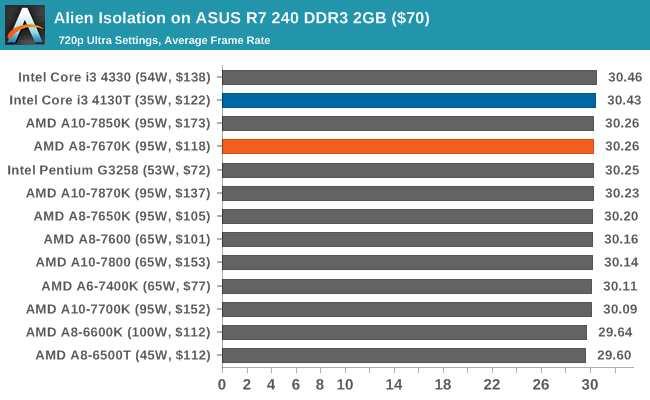
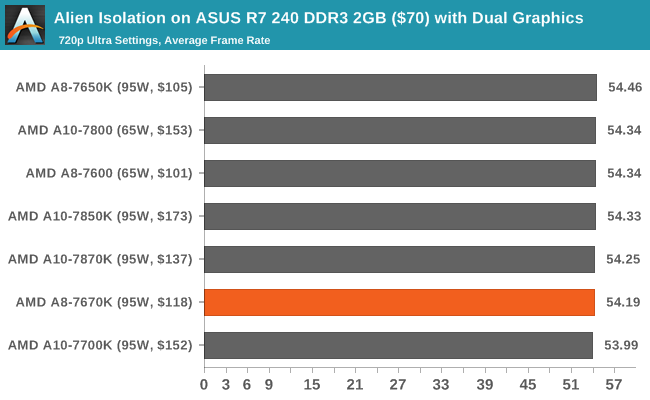
Total War: Attila
The Total War franchise moves on to Attila, another Creative Assembly development, and is a stand-alone strategy title set in 395AD where the main story line lets the gamer take control of the leader of the Huns in order to conquer parts of the world. Graphically, the game can render hundreds/thousands of units on-screen at once, all with their individual actions, and can put some of the big cards to task.
For low-end graphics, we test at 720p with performance settings, recording the average frame rate. With mid- and high-range graphics, we test at 1080p with the quality setting. In both circumstances, unlimited video memory is enabled, and the in-game scripted benchmark is used.
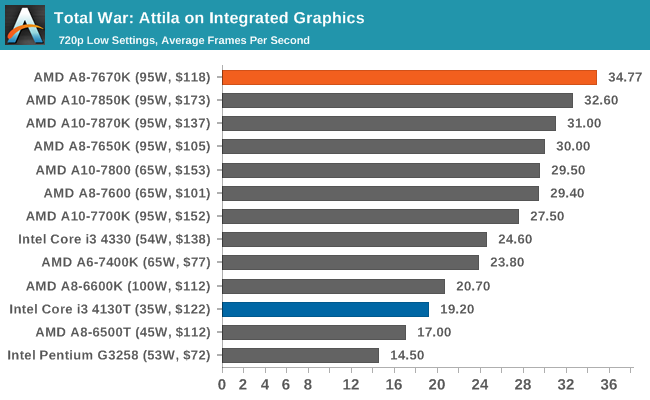

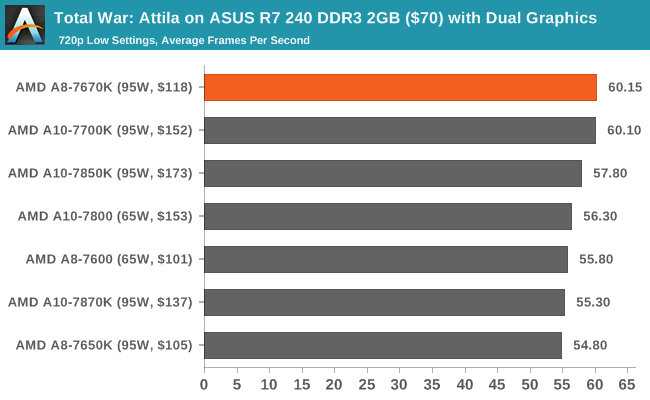
Grand Theft Auto V
The highly anticipated iteration of the Grand Theft Auto franchise finally hit the shelves on April 14, 2015, with both AMD and NVIDIA in tow to help optimize the title. GTA doesn’t provide graphical presets, but it opens up the options to users and extends the boundaries by pushing even the hardest systems to the limit using Rockstar’s Advanced Game Engine. Whether the user is flying high in the mountains with long draw distances or dealing with assorted trash in the city, when cranked up to maximum, it creates stunning visuals but hard work for both the CPU and the GPU.
For our test, we have scripted a version of the in-game benchmark, relying only on the final part, which combines a flight scene with an in-city drive-by, followed by a tanker explosion. For low-end systems, we test at 720p on the lowest settings, whereas mid- and high-end graphics play at 1080p with very high settings across the board. We record both the average frame rate and the percentage of frames under 60 fps (16.6 ms).

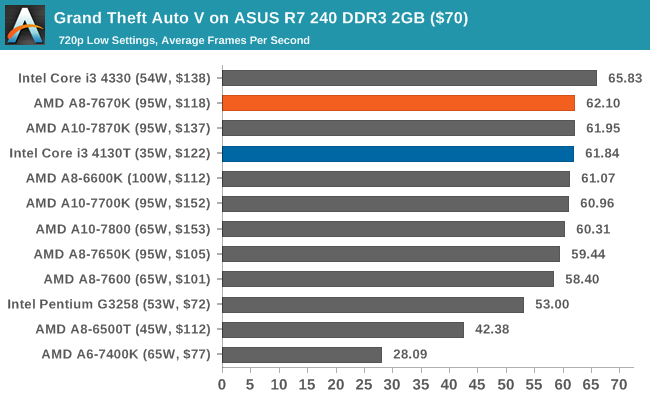
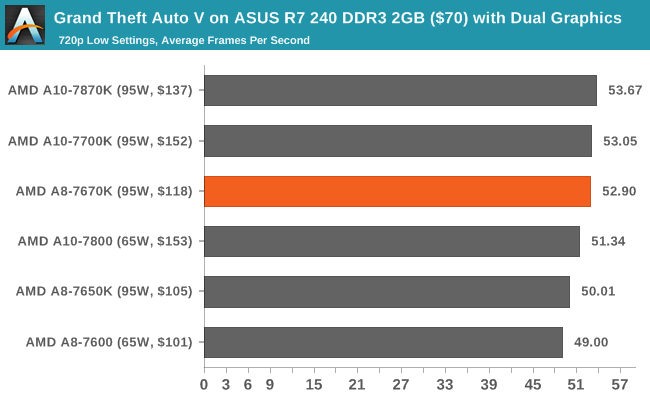
GRID: Autosport
No graphics test is complete without some input from Codemasters and the Ego engine, which means for this round of testing, we point toward GRID: Autosport, the next iteration in the GRID and racing genre. As with our previous racing testing, each update to the engine aims to add in effects, reflections, detail and realism, with Codemasters making "authenticity" a main focal point for this version.
GRID’s benchmark mode is very flexible, and as a result, we created a test race using a shortened version of the Red Bull Ring with 12 cars doing two laps. The player car is in focus throughout this benchmark and starts last, but usually finishes second or third. For low-end graphics, we test at 1080p and medium settings, whereas mid- and high-end graphics get the full 1080p maximum. Both the average and the minimum frame rates are recorded.
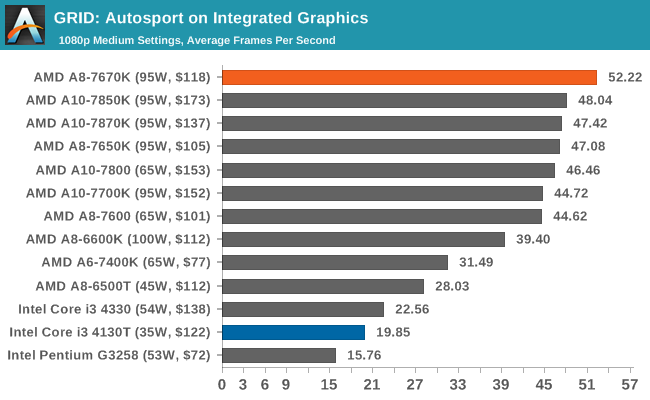
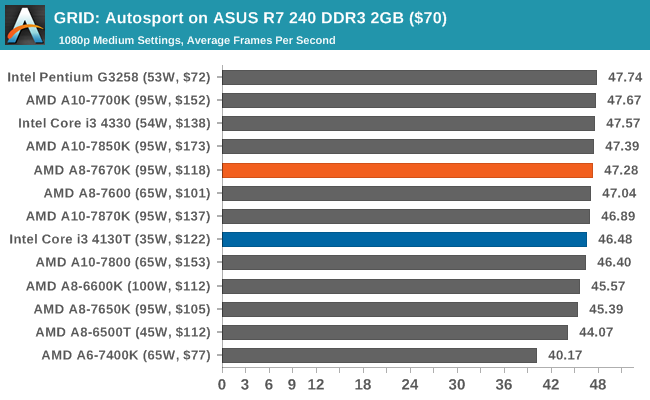
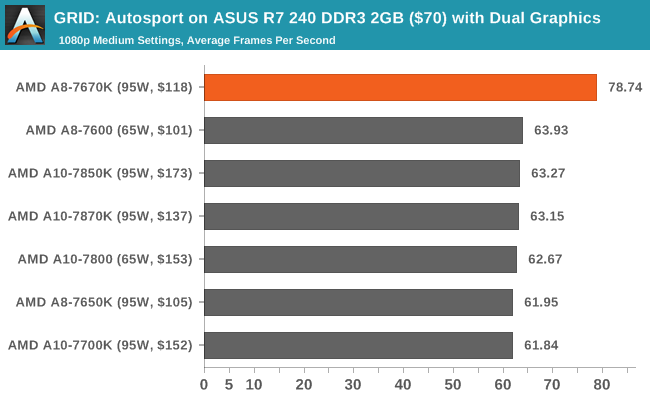
For whatever reason, the A8-7670K gets a good showing in the integrated tests, especially in dual graphics mode, with an abnormally high score. Some other issue might be at play here and warrants further testing.
Middle-Earth: Shadows of Mordor
The final title in our testing is another battle of system performance with the open-world action-adventure title Shadow of Mordor. Produced by Monolith using the LithTech Jupiter EX engine and numerous detail add-ons, SoM goes for detail and complexity to a large extent, despite having to be cut down from the original plans. The main story was written by the same writer as Red Dead Redemption, and it received Zero Punctuation’s Game of The Year in 2014.
For testing purposes, SoM gives a dynamic screen resolution setting, allowing us to render at high resolutions that are then scaled down to the monitor. As a result, we get several tests using the in-game benchmark. For low-end graphics, we examine at 720p with low settings, whereas mid- and high-end graphics get 1080p Ultra. The top graphics test is also redone at 3840x2160, also with Ultra settings, and we also test two cards at 4K where possible.
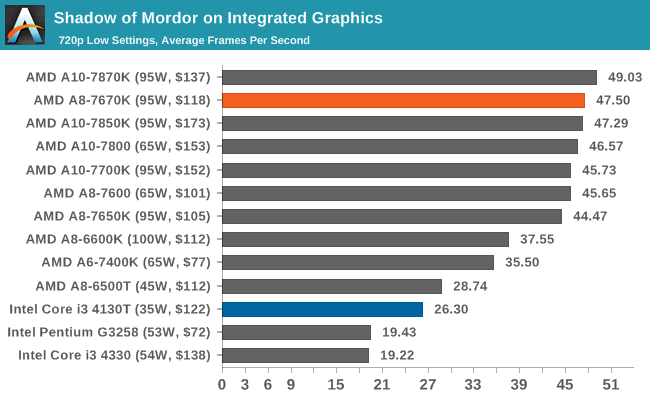
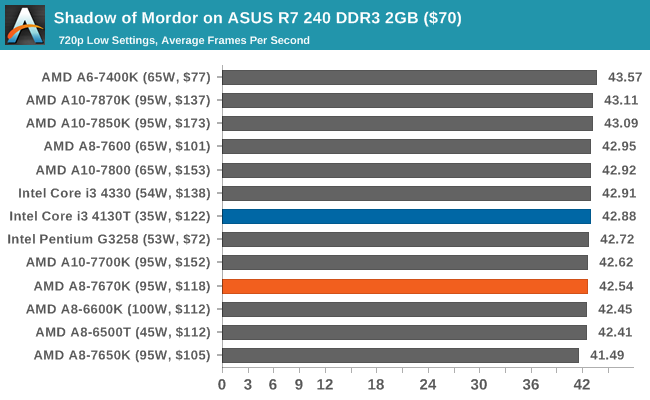
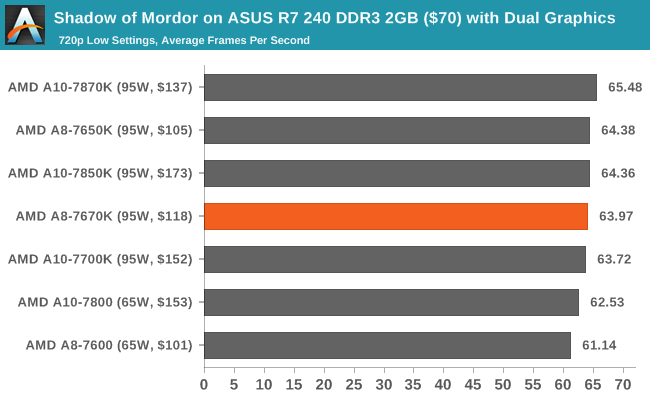















154 Comments
View All Comments
JoeMonco - Thursday, November 19, 2015 - link
So then why brin it up? What relevance does Netburst have to do with modern-day Intel or AMD?silverblue - Friday, November 20, 2015 - link
About as much relevance as you comparing current AMD CPU performance with that of Netburst.Other than that, it only serves to highlight that AMD have beaten Intel before, but I don't think Intel will get that complacent again anytime soon.
Klimax - Thursday, November 19, 2015 - link
Only because Intel made mistake. (And hit multiple unobvious problems later like frequency wall)JoeMonco - Wednesday, November 18, 2015 - link
Don't bring in your silly *facts*. This is an AMD wankfest where we ignore all evidence of claim and perpetually claim that [Year+1] is gonna be the year AMD releases that great CPU! Oh and we'll high five each other over AMD beating Netburst over a decade ago because that's hugely relevant still.anubis44 - Wednesday, November 18, 2015 - link
"This is an AMD wankfest where we ignore all evidence of claim and perpetually claim that [Year+1] is gonna be the year AMD releases that great CPU! Oh and we'll high five each other over AMD beating Netburst over a decade ago because that's hugely relevant still."Spoken like a true jerk. AMD's Zen is not a mere refresh of Bulldozer, and it wasn't designed by the same people who designed Bulldozer or Phenom/Phenom II. It was designed by the guy who is widely considered the very best CPU engineer on the planet. It's going to be entertaining to see what you have to say when AMD's comeback is truly in full swing.
JoeMonco - Thursday, November 19, 2015 - link
"It's going to be entertaining to see what you have to say when AMD's comeback is truly in full swing."No it'll actually be more entertaining when Zen fails like every other AMD processor for the last decade. Then you and your ilk will be going on and on about how Zen 2 is going to be the one to finally beat Intel.
sld - Thursday, November 19, 2015 - link
Well said by someone who enjoys paying the near-monopoly prices for Intel's CPUs.JoeMonco - Thursday, November 19, 2015 - link
No, I'm just a realist.BurntMyBacon - Thursday, November 19, 2015 - link
eanazag: "I fully expect AMD to disappoint with Zen. I see no facts that indicate they will not do what they did in the past - fail to meet expectations at the time they said they would."If your expectation is that AMD will disappoint with Zen, then I don't suppose they'd be too sad if they failed to meet that expectation ;' )
JoeMonco - Thursday, November 19, 2015 - link
Unless the benchmarks are going to translate into sales, it's not really going to matter.